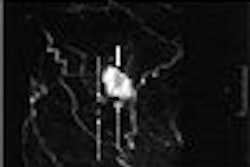The shift to volume sonography offers new possibilities and advantages for sonographers, according to James Pennington of Diagnostic Ultrasound Associates in Boston.
"Volume sonography is a totally different idea than what has been known before, and I think is entering an era where (just performing) 2D ultrasound is going to be a thing of the past," Pennington said.
Pennington spoke during a talk at the annual convention of the American Institute of Ultrasound in Medicine (AIUM), held earlier this year in Washington, DC.
Volume sonography allows for scanning in an infinite number of planes. It's the role of the sonographers to handle volume acquisition, volume display, and volume manipulation, Pennington said.
Volume acquisition is the summation of 2D slices obtained from the sweep of a specific probe. In preparing for the volume acquisition, sonographers select among options such as setting the size of the volume (the box), the angle of the acquisition, and the overall speed of the acquisition, he said.
With 3D scanning, the acquired volume permits an infinite number and different types of displays of the information, in both individual slices and total volume displays, he said.
"The volume contains all of the information that's available, and it is up to us (sonographers) to display it to advantage," Pennington said.
Sonographers can choose from four different display modes: three right-angled planes (multiplanar reformatting or MPR), surface rendering at an interface, inverse mode, and tomographic cuts parallel to each other (tomographic ultrasound imaging), he said.
With the three right-angled planes approach, the technology provides the ability to see anatomic sections in an orientation different from the acquisition section, Pennington said. The sonographer needs to manipulate the volume to display just the right plane.
Another mode, surface rendering at an interface, shows an image of the surface of an object, as long as enough fluid is in front of it to form a sufficient image, Pennington said. This display can be shown in various modes, such as soft-tissue or skeletal-type displays.
Inverse mode provides a unique display, according to Pennington. It shows a cast of all cystic portions within the volume in their entirety, while the grayscale portion of the image becomes transparent, he said.
Tomographic ultrasound imaging (TUI) allows for multislice display of the volume at fixed but flexible intervals, just like other forms of cross-sectional imaging, Pennington said. Slices can be 1-4 mm apart.
TUI-type displays offer clinical benefits, including allowing for viewing of the entire scan using the original volume acquisitions and the ability to display any combination of planes.
"This eliminates operator dependence," he said.
The impact of 3D sonography is far-reaching, Pennington said. With 3D sonography, images are less operator-dependent. And sonographers can spend less time scanning, which may improve the repetitive injuries they have, he noted.
Sonographers may also be called upon to reconstruct the views offline, which will vary their tasks and save physician time, Pennington said.
"This should vary their job description and reduce their injuries," he said.
By Erik L. Ridley
AuntMinnie.com staff writer
August 4, 2006
Related Reading
2D ultrasound offers similar info to 3D/4D obstetric US, June 8, 2006
3D ultrasound brings efficiency gains, May 25, 2006
3D sonography of the endometrium adds value, May 5, 2006
3D ultrasound predicts fetal pulmonary hypoplasia, April 21, 2006
3D ultrasound shows value in detecting fetal malformations, March 24, 2006
Copyright © 2006 AuntMinnie.com




















